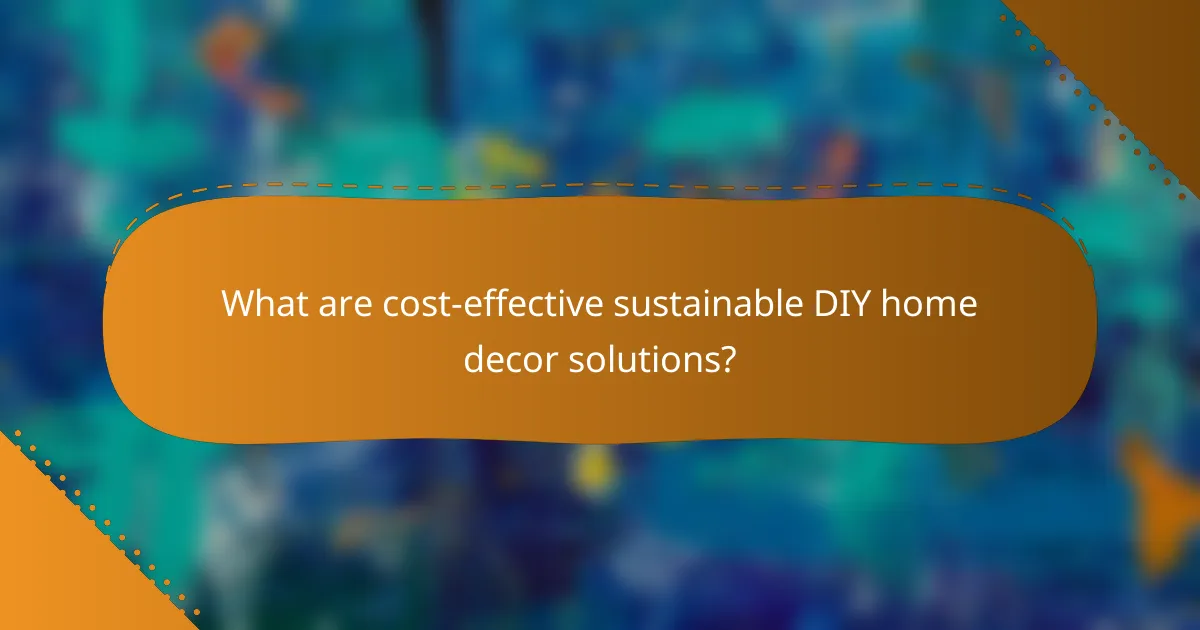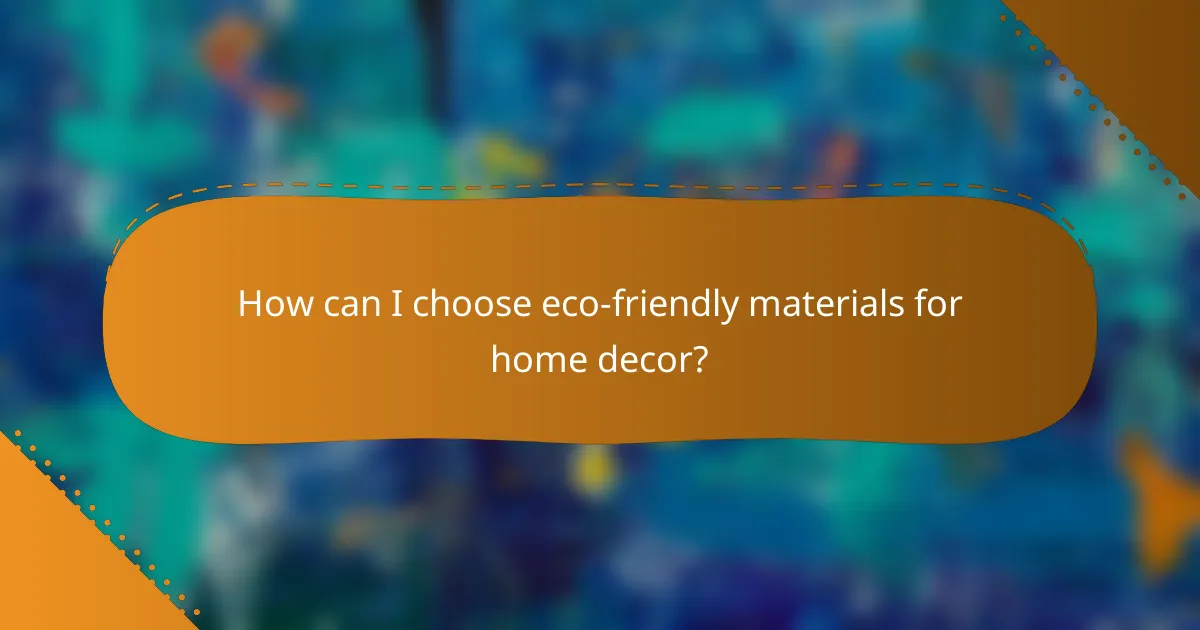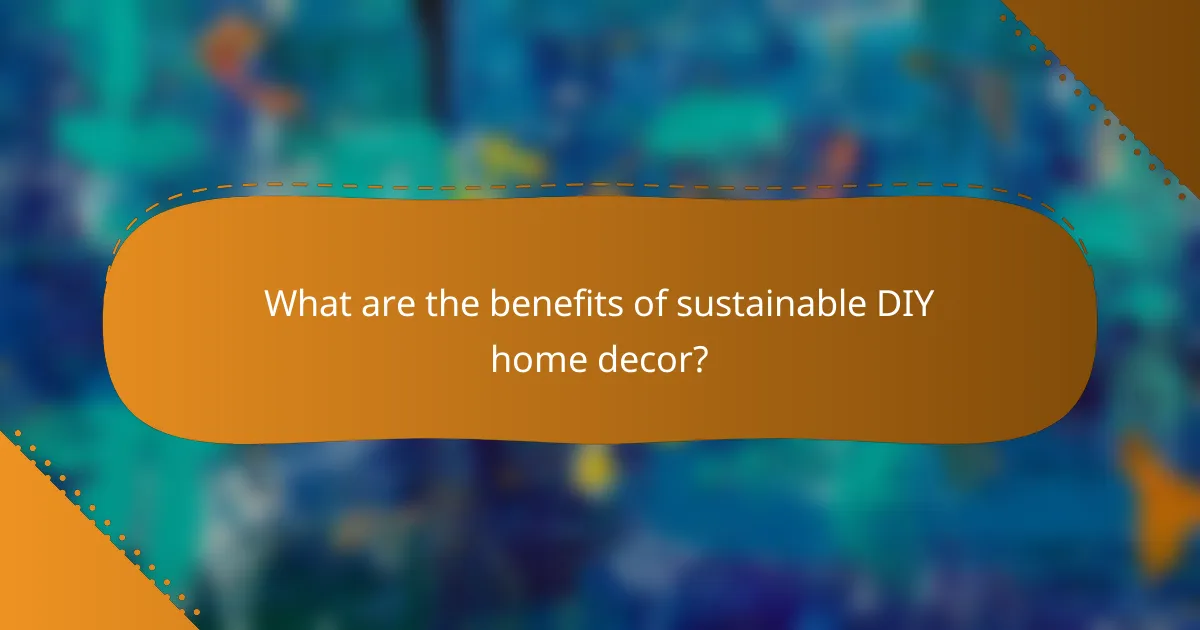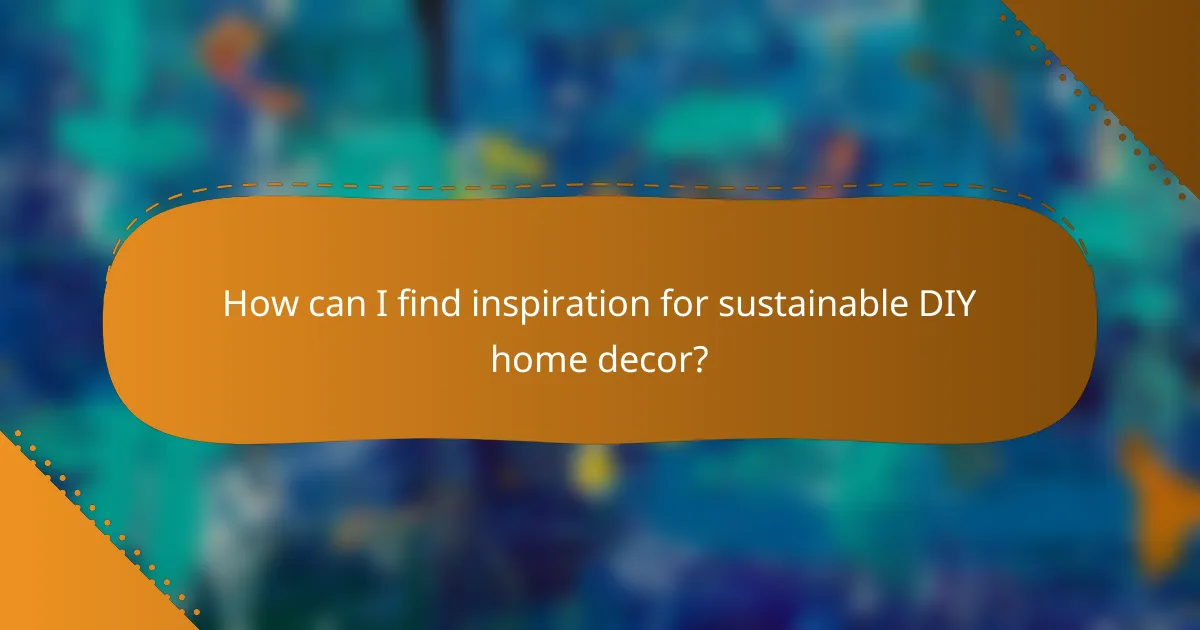Sustainable DIY home decor provides an opportunity to enhance your living space while being mindful of the environment and your budget. By utilizing eco-friendly materials and creative repurposing techniques, you can create beautiful decor that reflects your personal style without compromising on sustainability. Embracing these cost-effective solutions not only reduces your environmental footprint but also allows for a more personalized and meaningful home.

What are cost-effective sustainable DIY home decor solutions?
Cost-effective sustainable DIY home decor solutions utilize eco-friendly materials and creative techniques to enhance your living space without breaking the bank. These solutions often involve repurposing items you already own or sourcing inexpensive materials that minimize environmental impact.
Recycled materials for furniture
Using recycled materials for furniture can significantly reduce costs while promoting sustainability. Consider sourcing reclaimed wood from old pallets or furniture, which can be transformed into tables or shelves with minimal effort. Look for local recycling centers or online marketplaces where you can find affordable materials.
When selecting recycled materials, ensure they are in good condition and free from harmful chemicals. A simple sand and stain can revitalize worn wood, giving it a fresh look while maintaining its character.
Upcycled home accessories
Upcycling involves creatively repurposing items to create new home accessories, saving money and reducing waste. For example, glass jars can be transformed into stylish candle holders or storage containers, while old fabric can be sewn into decorative pillows or wall hangings.
To maximize your upcycling efforts, choose items that are versatile and can be easily modified. Keep an eye out for thrift store finds or items you no longer use that can be given a new life with a little creativity.
DIY wall art from natural elements
Creating DIY wall art from natural elements is an affordable way to bring the outdoors inside. You can use branches, leaves, or stones to craft unique pieces that reflect your personal style. For instance, a simple arrangement of twigs in a frame can create an eye-catching focal point.
Consider seasonal changes when selecting natural materials; for example, colorful autumn leaves can be preserved and framed for a warm, inviting look. Always ensure that the materials are ethically sourced and do not harm the environment.
Repurposed lighting fixtures
Repurposing lighting fixtures is a practical way to enhance your home decor while being budget-friendly. Old lampshades can be updated with new fabric or paint, and vintage light fixtures can be restored to add character to your space. Look for inspiration online or in home decor magazines for creative ideas.
When working with electrical components, ensure you follow safety guidelines and consider consulting a professional if you’re unsure about wiring. This will help you avoid potential hazards while achieving a stylish look.
Low-cost indoor plants
Incorporating low-cost indoor plants into your decor can improve air quality and add life to your home. Plants like pothos, snake plants, and spider plants are not only affordable but also easy to care for, making them perfect for beginners.
Consider propagating plants from cuttings to save money and expand your collection. Many plants can thrive in various lighting conditions, so choose varieties that suit your space and lifestyle. Regularly check for pests and ensure proper watering to keep your plants healthy.

How can I choose eco-friendly materials for home decor?
Choosing eco-friendly materials for home decor involves selecting items that are sustainable, non-toxic, and biodegradable. Focus on sourcing materials that minimize environmental impact while ensuring safety and durability in your living space.
Biodegradable textiles
Biodegradable textiles are made from natural fibers that break down easily in the environment, such as cotton, linen, and hemp. When selecting fabrics, look for those certified organic to avoid harmful pesticides and chemicals.
Consider using these textiles for curtains, cushions, and upholstery. They not only reduce waste but also contribute to healthier indoor air quality, making your home more comfortable.
Non-toxic paints and finishes
Non-toxic paints and finishes are essential for maintaining a safe living environment. Look for products labeled as low-VOC (volatile organic compounds) or zero-VOC, which emit fewer harmful chemicals into the air.
Brands that offer eco-friendly paints often use natural pigments and binders, making them safer for both your health and the planet. Always check for certifications like Green Seal or EcoLogo to ensure compliance with environmental standards.
Sustainable wood sources
Sustainable wood sources are harvested from responsibly managed forests that prioritize ecological balance. Look for certifications such as FSC (Forest Stewardship Council) or PEFC (Programme for the Endorsement of Forest Certification) when purchasing wooden furniture or decor.
Reclaimed wood is another excellent option, as it repurposes existing materials and reduces the demand for new timber. This not only conserves resources but also adds unique character to your home decor.

What are the benefits of sustainable DIY home decor?
Sustainable DIY home decor offers numerous advantages, including reduced environmental impact, long-term cost savings, and the ability to personalize your living space. By choosing eco-friendly materials and methods, you can create a home that reflects your values while being budget-conscious.
Environmental impact reduction
One of the primary benefits of sustainable DIY home decor is its potential to reduce environmental impact. By using reclaimed materials, natural fibers, and non-toxic paints, you minimize waste and lower your carbon footprint. This approach not only conserves resources but also promotes a healthier living environment.
Consider sourcing materials locally to further decrease transportation emissions. For example, repurposing old furniture or using salvaged wood can significantly lessen the demand for new resources, making your project more eco-friendly.
Cost savings over time
Engaging in sustainable DIY home decor can lead to substantial cost savings over time. While initial investments in eco-friendly materials may be higher, the durability and longevity of these products often result in lower replacement costs. For instance, using high-quality, sustainable wood can outlast cheaper alternatives, saving you money in the long run.
Additionally, many DIY projects can be completed with minimal tools and supplies, reducing overall expenditure. By creating your own decor, you can avoid the markup associated with store-bought items, allowing you to allocate your budget more effectively.
Personalization of living space
Sustainable DIY home decor allows for a high degree of personalization, enabling you to create a space that truly reflects your style and preferences. You can choose colors, textures, and designs that resonate with you, making your home uniquely yours. This level of customization is often not possible with mass-produced items.
Moreover, incorporating personal touches, such as handmade items or family heirlooms, can enhance the emotional value of your decor. Consider blending different styles or themes to create a cohesive look that showcases your individuality while remaining environmentally conscious.

What tools do I need for sustainable DIY projects?
To embark on sustainable DIY projects, you’ll need a selection of tools that facilitate eco-friendly practices while ensuring efficiency. Essential tools include hand tools, eco-friendly adhesives, and recycling tools to repurpose materials effectively.
Essential hand tools
Essential hand tools for sustainable DIY projects include basic items like hammers, screwdrivers, pliers, and saws. These tools allow you to manipulate materials without relying on energy-intensive power tools, making your projects more environmentally friendly.
Consider investing in high-quality, durable tools that can last for years, reducing waste. Look for tools made from recycled materials or those that are designed for easy repair and maintenance.
Eco-friendly adhesives
Eco-friendly adhesives are crucial for sustainable DIY projects, as they minimize harmful emissions and environmental impact. Options include natural glues made from plant-based materials, such as starch or casein, which are biodegradable and non-toxic.
When selecting adhesives, check for certifications like Green Seal or EcoLogo, which indicate lower environmental impact. Avoid traditional adhesives that contain volatile organic compounds (VOCs), as these can contribute to indoor air pollution.
Recycling tools for materials
Recycling tools help you repurpose materials effectively, making your DIY projects more sustainable. Tools such as a material cutter or a deconstruction tool can assist in breaking down old furniture or building materials for reuse.
Additionally, consider using a paint stripper or sander to refresh old surfaces instead of buying new materials. Always check local regulations regarding recycling and disposal to ensure compliance and maximize sustainability.

How can I find inspiration for sustainable DIY home decor?
Finding inspiration for sustainable DIY home decor can be achieved through various creative avenues. Utilizing online platforms, attending local workshops, and exploring eco-friendly blogs are effective ways to gather ideas and techniques that align with your sustainability goals.
Online platforms like Pinterest
Pinterest is a treasure trove for sustainable DIY home decor ideas. You can search for specific themes, such as “upcycled furniture” or “natural materials,” and discover countless images and tutorials. Create boards to save your favorite projects and refer back to them as you plan your own decor.
When using Pinterest, pay attention to the sources of the ideas. Look for tutorials that emphasize eco-friendly practices and materials to ensure your projects remain sustainable.
Local workshops and community events
Participating in local workshops and community events can provide hands-on experience with sustainable materials and techniques. Many community centers or eco-friendly stores offer classes on upcycling, crafting with natural materials, or even gardening, which can enhance your home decor.
Check local listings or social media groups for upcoming events. Engaging with others in your community can also spark new ideas and foster connections with like-minded individuals.
Eco-friendly home decor blogs
Eco-friendly home decor blogs are excellent resources for inspiration and practical tips. Many bloggers share their own DIY projects, along with detailed instructions and material lists, making it easier for you to replicate their work.
Look for blogs that focus on sustainable living and DIY projects, as they often highlight affordable, eco-conscious materials. Subscribing to these blogs can keep you updated on new trends and innovative ideas in sustainable home decor.


